PAGE 66 – October 2007
H O T I D E A S F O R S M A L L R A I L R O A D S

There’s an old Scottish saying that goes, “Many a mickle maks a muckle.”
It supposedly means “many littles makes a lot,” although it literally reads
“many a lot makes an abundance.” Whatever. Be that as it may, it’s certainly true
that many good, small things combine to make a good, small layout. Here are some
examples of a mickle of good ideas combining to make a muckle of good results!
A MUCKLE OF GREAT SCENERY FROM CANADA
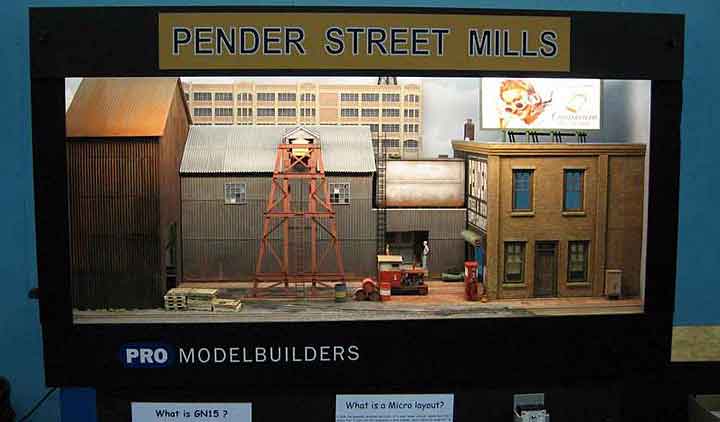
Brian Rudko, from Vancouver, BC, Canada, is combining a great many “small details” alongside some impressively large structures in his Gn15 layout, Pender Street Mills. Although the layout is still “under construction,” Brian exhibited it at the recent train show in nearby Victoria, BC. These photos were taken at the show by Brian Fayle, from near Toronto, himself a redoubtable builder of small layouts. He also sat in as an operator during the show, and declared the layout was “as good to operate as it is to look at.”
This 2x4ft layout was shown in its early construction stages in Scrapbook #54. It’s a pleasure to show some more photos of its progress, including adding a mickle of excellent details!
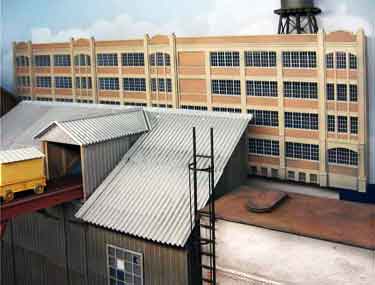
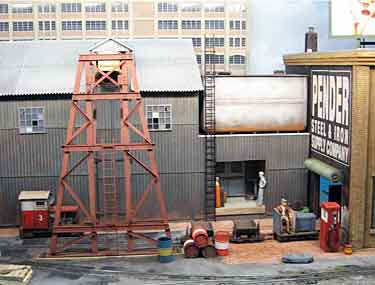
“All my buildings are removable using bolts and inserts,” Brian reports, “which makes it easy to work on any part of the base or on the building shells. All the building shells are acrylic with mostly Plastruct [Plastikard] siding on top. I used an HO structure in the back for a forced perspective. I am currently working on a ‘lit’ scene in the second floor of the brick office building. I haven’t yet decided what the light will reveal! I am still adding details and some detail painting, signs and such onto the buildings. I also need to build some rolling stock as well as design an operating system.”
There’s also a wealth of details that aren’t obvious from the front view of the layout. “I have a light mounted up top, and I have a sound chip from Miller Models installed with a speaker behind the buildings. It plays a ‘machine shop’ clamour, that I can turn on and off and up or down.”
Other hidden details include the fiddle yards at each end that make operations so pleasurable around Pender Street. The left side (below left) features a removable sector table pivoted at the edge of the baseboard and extending out beyond. The center photo shows the sector table in operation. At the right end (below right) is a two-track traverser (transfer table) that serves both the two visible sidings and a pair of hidden storage tracks at the rear.
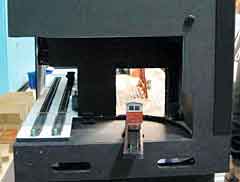
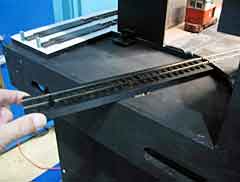
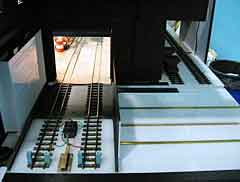
To give you a sense of the size of these G-scale buildings, here’s a photograph (below – photographer unknown) of the two Brians at the Victoria train show. Brian Rudko is sandwiched between Brian Fayle and the layout. For more examples of his outstanding modeling work, see the Pro Modelbuilders website (don’t miss the coffee cover models!).
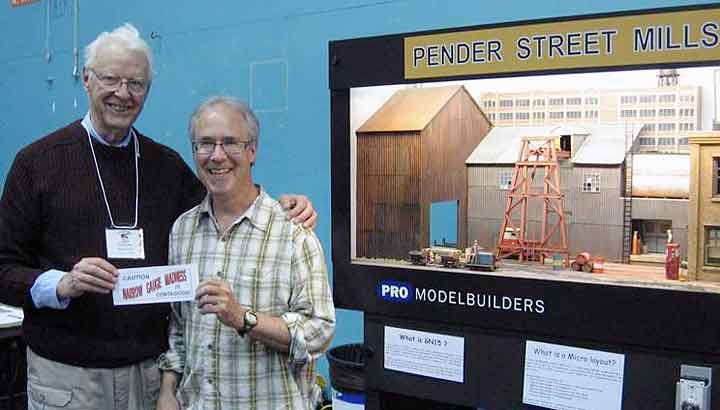
AND FROM ENGLAND, A MICKLE OF ENTERTAINING DETAILS
Meanwhile, across the Atlantic, Gerry Bullock is busily adding a wealth of details to another G-scale layout, Gneiss Farm, originally constructed and called Bramble Farm by Richard Andrews, who’s well-known for his small Gn15 layouts. One of the features Gerry has added is a wide variety of small animals and insects, which gives rise to a game for viewers: “”How many creatures can you spot on the layout?”
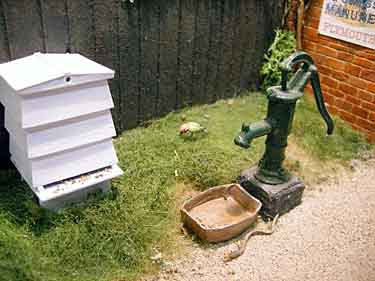
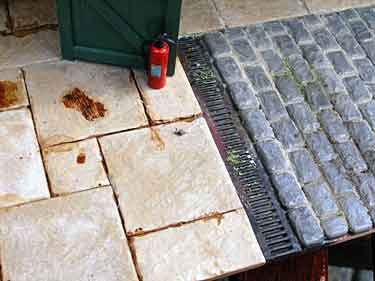
Gerry reports, “There are two horses, several sheep, numerous cats and rabbits, almost a dozen chickens and a dozen or so wild birds. I’m being cagey about exact numbers as part of the appeal of the layout is the challenge for Kids of all ages to find them all!” Here are a few photos to give you the idea. (Upper left) Near the new beehives from Sidelines models are a snake and a green woodpecker, not to mention innumerable bees (made from dried Earl Grey tea leaves)! The next photo (upper right) shows the layout’s resident snail, a first in my experience.
Below (left) is a more general shot showing many of the zoological exhibits; no prizes for spotting the rabbit and sheep, nor the cat climbing the ivy. At the right (below) are two of the many birds inhabiting this delightful farm. Aren’t G-scale details marvelous? There’s a similar find-the-critter game included in my original Gn15 layout, the Squarefoot Estate Railway.
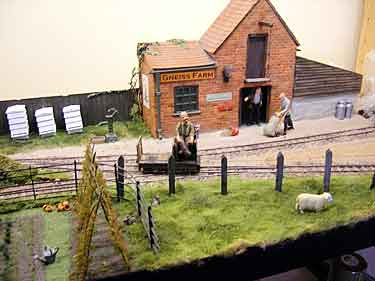
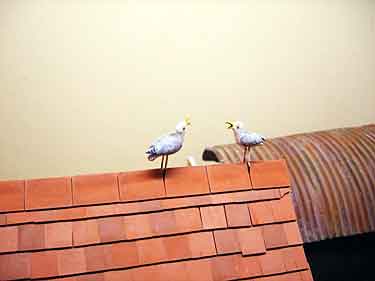
NEW LAYOUT FEATURES INTERESTING IDEAS
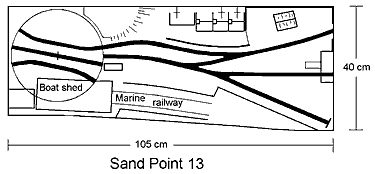
Richard Glover, of the Greenwich and District Narrow Gauge Railway Society in England, sent along a track plan and early photographs of his new layout, Sand Point. It’s a OO9 (4mm to the foot, 9mm gauge) harbour layout, measuring 105x40cm (41x16in). “It’s my first layout built on layers of foamed polystyrene, with a thin MDF skin for protection. It was certainly a learning experience!” Richard comments.
The mickle which may well mak a muckle on this layout is the planned boathouse slipway, which will feature a marine railway to transfer boats from the boathouse to the water. Should provide a most entertaining feature for the model! Both Richard and the Society, btw, are involved with ExpoNG, one of the world’s premier model train shows, scheduled for 27 October 2007 in Swanley, Kent, England.
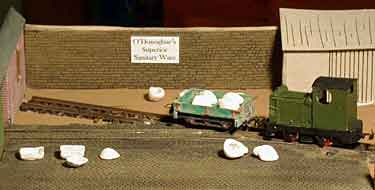
A TASTE OF CALVADOS FROM NORMANDY
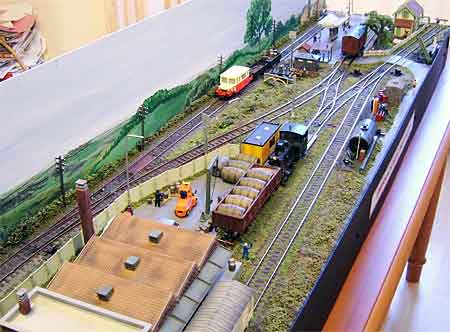
Graham Weller, from London (East Ham), England, continues to add details to his well-established French prototype layout, Embranchement Particulier (“Private Siding”). “The size of the layout is 48x12in (1220x300mm), the scale is H0, and the layout is based on the Normandy Region in France,” Graham declares. “It represents a small yard serving a Calvados apple pressing plant. The private shunting loco exchanges wagons with the passing SNCF branch line, on which can also can be seen the occasional passenger railcar. Recently a small 12in fiddle siding has been added at the left-hand end.”
To understand the importance of small details in creating the over-all impression of a layout, try to imagine the station scene (below left) without the well done telephone wires!
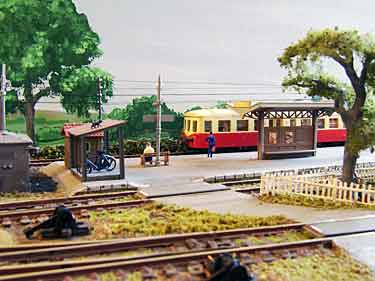
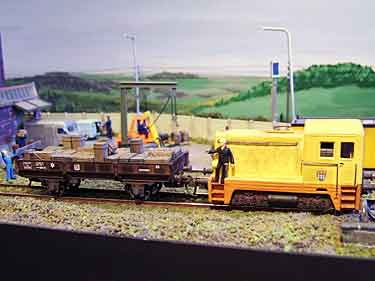
FRENCH QUARRY LINE FOCUSES ON UNUSUAL DETAILS
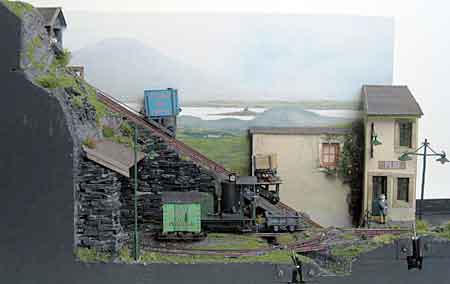
Frequent contributor François Fontana, from Saint Ettienne, France, recently forwarded some photos of his classic shoebox layout, Berlands Slate Quarry (featured in “Shoebox Madness” on this site). This marvelous little line illustrates the importance of selecting just the right details — in this case, the incline and associated trackage — to make viewing the layout a memorable experience.
It’s no coincidence that François sent closeup shots of the incline platforms and the rolling stock and counterweight (made of paper!), as well as the kickswitch and integral approach track.
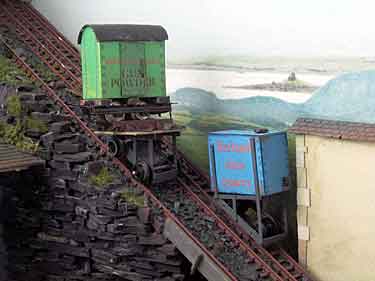
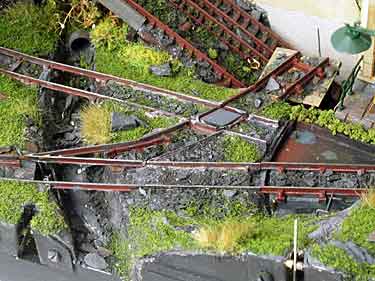
SMALL DISNEY MINERS DIG UP BIG-TIME OPERATING FUN
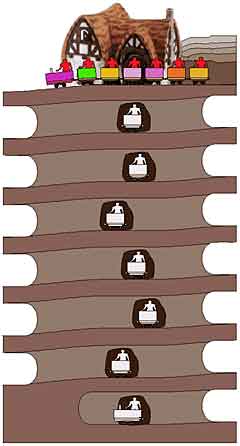
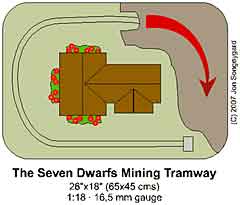
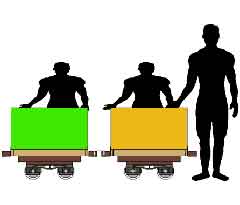

Jon Songøygard, who lives in Arendal, Norway, is one of the most imaginative contributors to this site. This time, he has put together seven “little things” (dwarfs) and some other practical details to make a working “cartoon” layout, the Snow White Coal Company!
The miners come from the Disney movie, “Snow White and the Seven Dwarfs” — their availability as a set of figures from a German company called Bullyland (see photo) makes the layout possible. The company also offers the dwarfs’ house as a model, so the setting can be authentic. Prince Charming, also available but not used on this layout, is 10cm tall; assuming his height is six feet, then the model scale is 1:18. So each dwarf is about 1 meter tall.
Either 16.5mm or 9mm gauge would work well … Jon opted for HO representing 300mm (12in) gauge, because several small motor mechanisms are available that can easily form the basis of a scratchbuilt locomotive. Six scratchbuilt coal cars will be needed, each built on an HO truck [bogie] — the dwarfs’ size relative to the rolling stock is demonstrated in the drawing (top center). For operation, each dwarf will be assigned to a car, with the seventh, most likely Doc, acting as locomotive driver.
Jon describes the layout this way: “The track plan is simple (top left). The railroad has a single track in front of the cottage, which makes a turn around the house, enters a tunnel and then spirals down into the earth. The side view drawing (at right) shows a side shaft for each of the seven miners, entering further into the base. This needs not be much more than a hole next to the decoupling spots for the cars, just large enough for the small men to enter.
“Now for the operation: I suppose you’ve seen how Disney vehicles usually move — full speed down the rails, locomotive first! This goes on until the train’s last car reaches the first side shaft. Then the train screeches to a stop, allowing the car to decouple. This is repeated for the next five side shafts, till the loco finally arrives at the lowest side shaft, where the engineer can enter. When the day’s work is done, the engineer re-enters his loco and speeds uphill, bumping into and coupling to the six cars on his way up, until the train again appears in open space and halts in front of the cottage, to be greeted by the waiting Snow White.”
Jon also points out that on his side view drawing the shafts are all on one side of the layout, more ore less above each other. This gives a total height of about one meter (40in). Putting the side shafts half a turn apart would cut the height in half and provide for good viewing from all sides.
There are many opportunities for animation on this little layout. Figuring out a way for the dwarfs to dismount from their wagons and enter the side shafts should provide a challenge, especially if they need to light and carry a lantern as they go. Sound effects are a natural — birds singing above ground, the sounds of picks and grunts below ground, and above all, the dwarfs singing “Heigh-ho, heigh-ho!” as their evening train rises toward home.
It’s probably not everyone’s cup of tea, but Jon has put together a mickle of ingredients that make a muckle of a layout that can bring joy to viewers from almost any generation!
GOING AROUND IN THE BEST CIRCLES
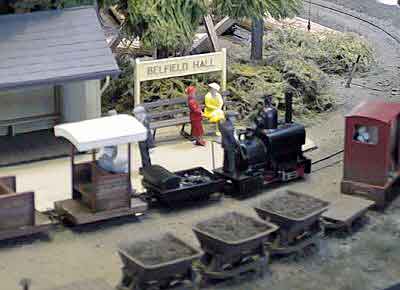
In 1990 Stephen Brown, who lives near London, England, built a small circular layout named Belfield Hall Estate Railway. Its story, plan and some photos are on his website. The O9/On18 layout was immensely popular, toured British exhibitions for nearly a decade, and inspired many people to have a go at building a small layout. Stephen’s rotating circular baseboard became a landmark design in the hobby.
Stephen recently began a new layout (of which more later). In the process, he found some of his 1990s designs, two of them for circular layouts published in the original BHER article. He thought they might be interesting and new to many readers of these pages, so he sent them to me saying, “Do you think these are worth republishing?” You bet I do! Here they are!
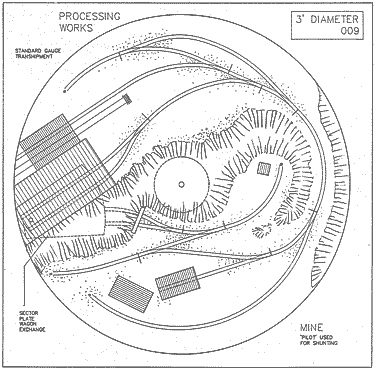
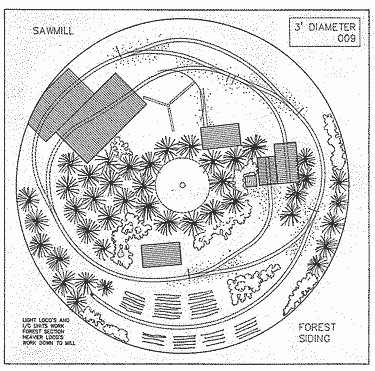
Both these OO9/HOn30 layouts are 36in (91cm) in diameter. One depicts a mining railway (left), the other a forestry (lumber) line. Both address “the problem of having full and empty stock going aimlessly back and forth around the layout.” Both “solve” the problem (and mak a muckle!) by providing destinations to deliver full and empty cars respectively, as well as ways to allow them always to travel in the correct directions.
The mining layout uses a concealed two-track sector plate to provide both destination and source for cars. The loco hauls full cars from the mine, pulls them round the layout and shunts them into the processing plant building, onto the sector plate. It gathers a train of empties from the other track of the plate and returns to the mine, where it shunts the empties back into the same sector plate track (which has been secretly swiveled to serve the mine tracks) and picks up the full cars again. Repeat to taste. This technique is very similar to John Armstrong’s familiar “empties in/loads out” designs.
The timber layout works much the same way, except the deliveries and pickups are made to run-through sheds, rather than to a sector plate. The pickup and delivery strategies are the same. This layout also allows some “stealth” round-and-round operation. Both layouts use the circular format to very good effect.
Our thanks to Stephen for sharing his still-inspiring ideas with a new group of readers who may not be familiar with them. We hope to see more of his new layout in the future.
PUTTING IT TOGETHER: MANY SMALL DETAILS YIELD GREAT EFFECT

Les Mages is slightly larger than our usual layouts — it’s 3.7m (12ft)long — but I think you’ll agree that it provides plenty of inspiration for small layout builders! Gilbert Gribi, a well-known European modeler who lives near Lausanne in Switzerland, built this 60cm (two-foot) gauge timber line and equipped it with two delightful little Decauville 0-4-0 steamers.
Gilbert excels at modeling detailed scenery, maintaining the difficult balance between providing enough detail to emulate real life without overdoing it and descending into indiscriminate clutter. Les Mages is a classic example of how a lot of “little things” can combine to make a stunning layout. In this case, many a mickle does indeed mak a muckle! The photos speak for themselves. Gilbert has many more at his website. I hope you enjoy them all.
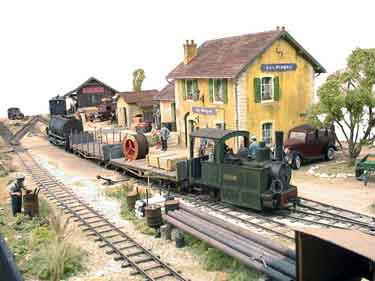
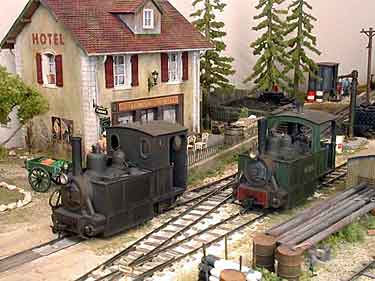
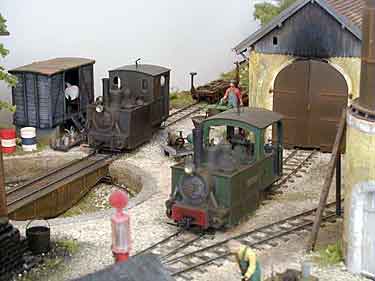
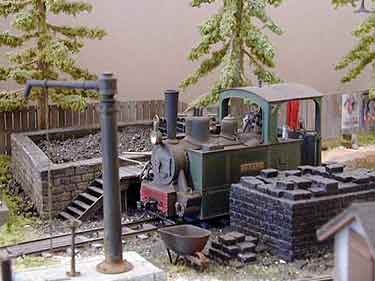
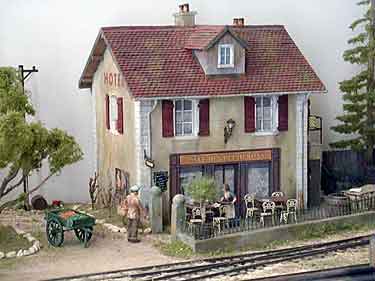
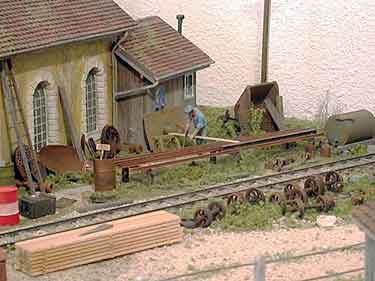
Leave a Reply